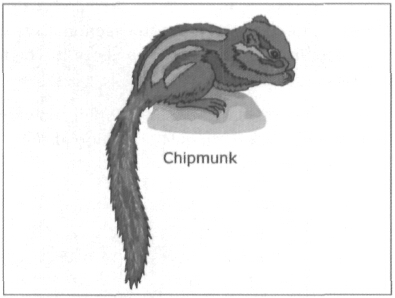Ecologists have studied the four chipmunk species that occur on the eastern slope of the S
Which of the sentences below best expresses the essential information in the highlighted sentence in paragraph 4? Incorrect choices change the meaning in important ways or leave out essential information.
A.Ecologists studied how the geographic characteristics of the eastern slope of the Sierra influenced the social development of chipmunks.
B.Ecologists learned exactly how chipmunk species separated from each other on the eastern slope of the Sierra relate to one another.
C.Ecologists discovered that chipmunks of the eastern slope of the Sierra invade and occupy higher elevational zones when threatened by another species.
D.Ecologists studied how individual chipmunks of the eastern slope of the Sierra avoid interacting with others of their species.
 搜題
搜題
第1題
The phrase "one another" in the passage refers to
A.populations
B.races
C.ecological conditions
D.species
第2題
olated from one another by mountains and unfavorable ecological habitat. These scattered populations first evolved into races—adapted to the local ecological conditions—and then into species, reproductively isolated from one another. This period of evolution was relatively recent, as evidenced by the similar appearance of all the western chipmunk species.
The word "diverged" in the passage is closest in meaning to
A.declined
B.competed
C.progressed
D.separated
第3題
tern North America because of
A.a large migration of chipmunks from eastern North America in an earlier period
B.the inability of chipmunks to adapt to the high mountainous regions of eastern North America
C.the ecological variety and extremes of the West that caused chipmunks to become geographically isolated
D.the absence of large human populations that discouraged species formation among chipmunks in the East
第4題
three passages in the section. Give yourself 20 minutes to read each passage and answer the questions about it. The entire section will take 60 minutes to complete. You may look back at a passage when answering the questions. You can skip questions and go back to them later as long as there is time remaining. Directions: Read the passage. Then answer the questions. Give yourself 20 minutes to complete this practice set. HABITATS AND CHIPMUNK SPECIES
 There are eight chipmunk species in the Sierra Nevada mountain range, and most of them look pretty much alike. But eight different species of chipmunks scurrying around a picnic area will not be found. Nowhere in the Sierra do all eight species occur together. Each species tends strongly to occupy a specific habitat type, within an elevational range, and the overlap among them is minimal. The eight chipmunk species of the Sierra Nevada represent but a few of the 15 species found in western North America, yet the whole of eastern North America makes do with but one species: the Eastern chipmunk. Why are there so many very similar chipmunks in the West? The presence of tall mountains interspersed with vast areas of arid desert and grassland makes the West ecologically far different from the East. The West affords much more opportunity for chipmunk populations to become geographically isolated from one another, a condition of species formation. Also, there are more extremes in western habitats. In the Sierra Nevada, high elevations are close to low elevations, at least in terms of mileage, but ecologically they are very different. Most ecologists believe that ancient populations of chipmunks diverged genetically when isolated from one another by mountains and unfavorable ecological habitat. These scattered populations first evolved into races—adapted to the local ecological conditions—and then into species, reproductively isolated from one another. This period of evolution was relatively recent, as evidenced by the similar appearance of all the western chipmunk species. Ecologists have studied the four chipmunk species that occur on the eastern slope of the Sierra and have learned just how these species interact while remaining separate, each occupying its own elevational zone. The sagebrush chipmunk is found at the lowest elevation, among the sagebrush. The yellow pine chipmunk is common in low to mid-elevations and open conifer forests, including pinon and ponderosa and Jeffrey pine forests. The lodgepole chipmunk is found at higher elevations, among the lodgepoles, firs, and high-elevation pines. The alpine chipmunk is higher still, venturing among the talus slopes, alpine meadows, and high-elevation pines and junipers. Obviously, the ranges of each species overlap. Why dont sagebrush chipmunks move into the pine zones? Why dont alpine chipmunks move to lower elevations and share the conifer forests with lodgepole chipmunks? The answer, in one word, is aggression. Chipmunk species actively defend their ecological zones from encroachment by neighboring species. The yellow pine chipmunk is more aggressive than the sagebrush chipmunk, possibly because it is a bit larger. It successfully bullies its smaller evolutionary cousin, excluding it from the pine forests. Experiments have shown that the sagebrush chipmunk is physiologically able to live anywhere in the Sierra Nevada, from high alpine zones to the desert. The little creature is apparently restricted to the desert not because it is specialized to live only there but because that is the only habitat where none of the other chipmunk species can live. The fact that sagebrush chipmunks tolerate very warm temperatures makes them, and only them, able to live where they do. The sagebrush chipmunk essentially occupies its habitat by default. In one study, ecologists established that yellow pine chipmunks actively exclude sagebrush chipmunks from pine forests; the ecologists simply trapped all the yellow pine chipmunks in a section of forest and moved them out. Sagebrush chipmunks immediately moved in, but yellow pine chipmunks did not enter sagebrush desert when sagebrush chipmunks were removed. The most aggressive of the four eastern-slope species is the lodgepole chipmunk, a feisty rodent indeed. It actively prevents alpine chipmunks from moving downslope, and yellow pine chipmunks from moving upslope. There is logic behind the lodge-poles aggressive demeanor. It lives in the cool, shaded conifer forests, and of the four species, it is the least able to tolerate heat stress. It is, in other words, the species of the strictest habitat needs: it simply must be in those shaded forests. However, if it shared its habitat with alpine and yellow pine chipmunks, either or both of these species might outcompete it, taking most of the available food. Such a competition could effectively eliminate lodgepole chipmunks from the habitat. Lodgepoles survive only by virtue of their aggression. Directions: Now answer the questions. There are eight chipmunk species in the Sierra Nevada mountain range, and most of them look pretty much alike. But eight different species of chipmunks scurrying around a picnic area will not be found. Nowhere in the Sierra do all eight species occur together. Each species tends strongly to occupy a specific habitat type, within an elevational range, and the overlap among them is minimal.
There are eight chipmunk species in the Sierra Nevada mountain range, and most of them look pretty much alike. But eight different species of chipmunks scurrying around a picnic area will not be found. Nowhere in the Sierra do all eight species occur together. Each species tends strongly to occupy a specific habitat type, within an elevational range, and the overlap among them is minimal. The eight chipmunk species of the Sierra Nevada represent but a few of the 15 species found in western North America, yet the whole of eastern North America makes do with but one species: the Eastern chipmunk. Why are there so many very similar chipmunks in the West? The presence of tall mountains interspersed with vast areas of arid desert and grassland makes the West ecologically far different from the East. The West affords much more opportunity for chipmunk populations to become geographically isolated from one another, a condition of species formation. Also, there are more extremes in western habitats. In the Sierra Nevada, high elevations are close to low elevations, at least in terms of mileage, but ecologically they are very different. Most ecologists believe that ancient populations of chipmunks diverged genetically when isolated from one another by mountains and unfavorable ecological habitat. These scattered populations first evolved into races—adapted to the local ecological conditions—and then into species, reproductively isolated from one another. This period of evolution was relatively recent, as evidenced by the similar appearance of all the western chipmunk species. Ecologists have studied the four chipmunk species that occur on the eastern slope of the Sierra and have learned just how these species interact while remaining separate, each occupying its own elevational zone. The sagebrush chipmunk is found at the lowest elevation, among the sagebrush. The yellow pine chipmunk is common in low to mid-elevations and open conifer forests, including pinon and ponderosa and Jeffrey pine forests. The lodgepole chipmunk is found at higher elevations, among the lodgepoles, firs, and high-elevation pines. The alpine chipmunk is higher still, venturing among the talus slopes, alpine meadows, and high-elevation pines and junipers. Obviously, the ranges of each species overlap. Why dont sagebrush chipmunks move into the pine zones? Why dont alpine chipmunks move to lower elevations and share the conifer forests with lodgepole chipmunks? The answer, in one word, is aggression. Chipmunk species actively defend their ecological zones from encroachment by neighboring species. The yellow pine chipmunk is more aggressive than the sagebrush chipmunk, possibly because it is a bit larger. It successfully bullies its smaller evolutionary cousin, excluding it from the pine forests. Experiments have shown that the sagebrush chipmunk is physiologically able to live anywhere in the Sierra Nevada, from high alpine zones to the desert. The little creature is apparently restricted to the desert not because it is specialized to live only there but because that is the only habitat where none of the other chipmunk species can live. The fact that sagebrush chipmunks tolerate very warm temperatures makes them, and only them, able to live where they do. The sagebrush chipmunk essentially occupies its habitat by default. In one study, ecologists established that yellow pine chipmunks actively exclude sagebrush chipmunks from pine forests; the ecologists simply trapped all the yellow pine chipmunks in a section of forest and moved them out. Sagebrush chipmunks immediately moved in, but yellow pine chipmunks did not enter sagebrush desert when sagebrush chipmunks were removed. The most aggressive of the four eastern-slope species is the lodgepole chipmunk, a feisty rodent indeed. It actively prevents alpine chipmunks from moving downslope, and yellow pine chipmunks from moving upslope. There is logic behind the lodge-poles aggressive demeanor. It lives in the cool, shaded conifer forests, and of the four species, it is the least able to tolerate heat stress. It is, in other words, the species of the strictest habitat needs: it simply must be in those shaded forests. However, if it shared its habitat with alpine and yellow pine chipmunks, either or both of these species might outcompete it, taking most of the available food. Such a competition could effectively eliminate lodgepole chipmunks from the habitat. Lodgepoles survive only by virtue of their aggression. Directions: Now answer the questions. There are eight chipmunk species in the Sierra Nevada mountain range, and most of them look pretty much alike. But eight different species of chipmunks scurrying around a picnic area will not be found. Nowhere in the Sierra do all eight species occur together. Each species tends strongly to occupy a specific habitat type, within an elevational range, and the overlap among them is minimal.
Why does the author mention a "picnic area" in paragraph 1?
A.To identify a site where a variety of different species of chipmunks can be seen
B.To support the point that each species of chipmunk inhabits a distinct location
C.To emphasize the idea that all species of chipmunks have a similar appearance
D.To provide an example of a location to which chipmunks are likely to scurry for food
第5題
Listen to Track 31.

A.To support the student"s statement
B.To ask the student to clarify her statement
C.To find out if the students know what story the line comes from
D.To clarify the relationship between time and space in fairy tales
第6題
cate the characteristics of each type of tale. Put a check in the correct boxes.

第7題
What does the professor say about the setting of fairy tales?
A.The tales are usually set in a nonspecific location.
B.The location is determined by the country of origin of a tale.
C.The tales are set in a location familiar to the author.
D.A storyteller varies the location of a tale depending on the audience.
第8題
Why does the professor clarify the concept of a "fairy"?
A.To explain the origins of the term "fairy tale"
B.To eliminate a possible definition of the term "fairy tale"
C.To support a claim about the function of fairy tales
D.To indicate that fairies are a major element in fairy tales
第9題
What does the professor mean when he says that folktales are communal?
A.They vary little from one community to another.
B.They serve to strengthen ties among individuals within a community.
C.They relate important events in the history of a community.
D.They can be adapted to meet the needs of a community.
第10題
What is the lecture mainly about?
A.Oral traditions in folktales and fairy tales
B.Common characters and plots in folktales and fairy tales
C.Differences between folktales and fairy tales
D.Hidden meanings in folktales and fairy tales































